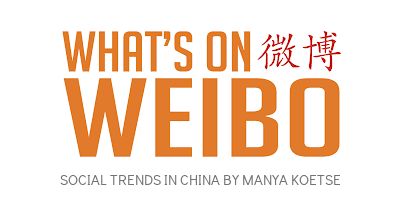FROM THE WEIBO WATCH PREMIUM NEWSLETTER
Dear Reader,
It’s been a tumultuous news week, with discussions and trending topics on Chinese social media going from international events like the Myanmar earthquake or the impeachment of South Korean (former) President Yoon Suk Yeol to major discussions on the safety and abuse of the autopilot feature on electric vehicles, the US trade war, and new military exercises around Taiwan.
🧹 With so much going on, this year’s Qingming Festival (清明节) felt especially welcome. Also known as Tomb-Sweeping Day, Qingming fell on April 4 this year. It is a special time to reflect, pause, and honor family ancestors by visiting graves, making offerings, and burning spirit money.
🧳 It’s also a public holiday and a popular time for travel. And so, instead of a quiet time, many popular tourist spots across China turned into a sea of people. One example is Qingdao, where the famous Zhanqiao Pier (栈桥) — the one featured on the Tsingtao Beer label — became more people than pier. That crowded hotspot scene sparked the trending hashtag “#人人人人栈桥人人人人#”: People-People-People-People-Zhanqiao-People-People-People-People.
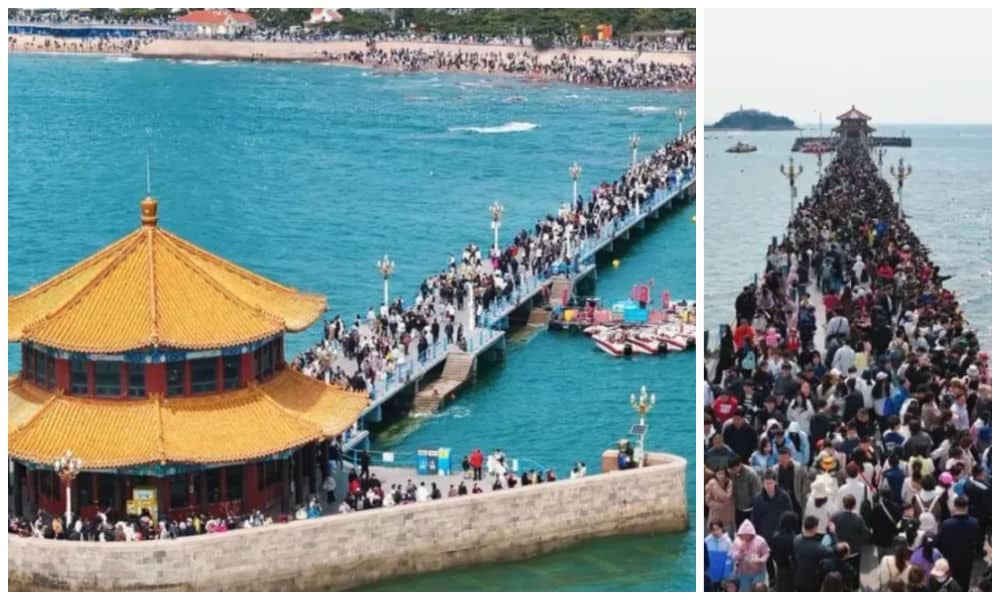
More people than pier in Qingdao, images via Qingdao Daily 青岛日报
On Chinese social media, it has become somewhat of a tradition to post about just how busy it is at China’s various sightseeing spots. This is often done using the hashtags “人人人人[place]人人人人” or “人人人人[me]人人人人.” The character 人 (rén) means person or human; “人人” (rénrén) means “everyone,” and the more “人人人” (rén rén rén) are used, the more it playfully emphasizes the crowds of people.
Since it was also very crowded this weekend at Hangzhou West Lake, Mount Qingcheng, the Longmen Grottoes, the Hubei Provincial Museum (people lining up to see the Sword of Gouijan), and many other places, there were similar hashtags for various places going around Weibo.
📰 Qingming Festival is also a busy time for state media, as the holiday ties into broader narratives about the nation and remembering those who defended the homeland.
State media-initiated hashtags like “Forever Remember [for] the Homeland, Salute to Our Heroes” (#家国永念致敬英雄#) are used in posts about key commemorations — such as the China Coast Guard observing a moment of silence facing the sea and scattering flowers in honor of China’s martyrs.

CCTV poster 家国永念, Always Remember [for] the Homeland.
One especially notable grave visit covered by the media this weekend was that of Mao Xinyu (毛新宇), the only surviving grandson of Mao Zedong. He returned to Mao’s birthplace, Shaoshan, with his family to pay tribute to his grandfather. At the statue of Mao, great-granddaughter Mao Tianyi (毛甜懿) also spoke a few words, wishing her great-grandfather peace and expressing hope that she could live up to his expectations (see video).
💸 For China’s paper offering businesses, the period around Qingming Festival is anything but quiet. Over the past years—and especially in the age of booming e-commerce—the ancient ritual of paper offerings has undergone major transformations and become increasingly extravagant. By burning ritual paper gifts, it’s believed that these offerings are sent to the afterlife.
To please the ancestors—and perhaps sometimes to impress the neighbors, too—people now burn all kinds of things, from paper liquor to cardboard Rolex watches. Some take it a step further, creating entire paper replicas of two-story villas or palaces to honor their ancestors. Chinese media reported that one vendor in Jiangsu’s Nantong was selling a 200 m² paper villa, complete with rooms, for 15,000 yuan ($2,060)—it even had a car in the driveway (video)! Another video showed neighbors gathering to watch such a paper mansion go up in flames.

This year, one item that particularly caught attention on WeChat and Xiaohongshu was a paper version of the Xiaomi SU7 EV. A video showing these offerings strapped to the back of a delivery scooter went viral—apparently, Xiaomi is more popular than BMW this year (read last year’s article about Burning BMWs here).
🪦 At least for the people visiting their family’s graves and bringing offerings, Qingming should be a relaxing time, right? Not exactly — or at least, not for everyone. This year, the Qingming Festival ancestral worship activities of the “South China F3” (华南F3, referring to Guangdong, Guangxi, and Hainan) have sparked widespread discussion for just how dramatic and hardcore they can get.
Many people in these southern provinces, especially in rural and mountainous areas, have become known for going all out when it comes to ancestral worship during Qingming. Climbing mountains, entering caves, wading through rivers — some ancestral graves are so hidden that tomb-sweeping day feels more like a wilderness survival challenge for the families trying to reach them.
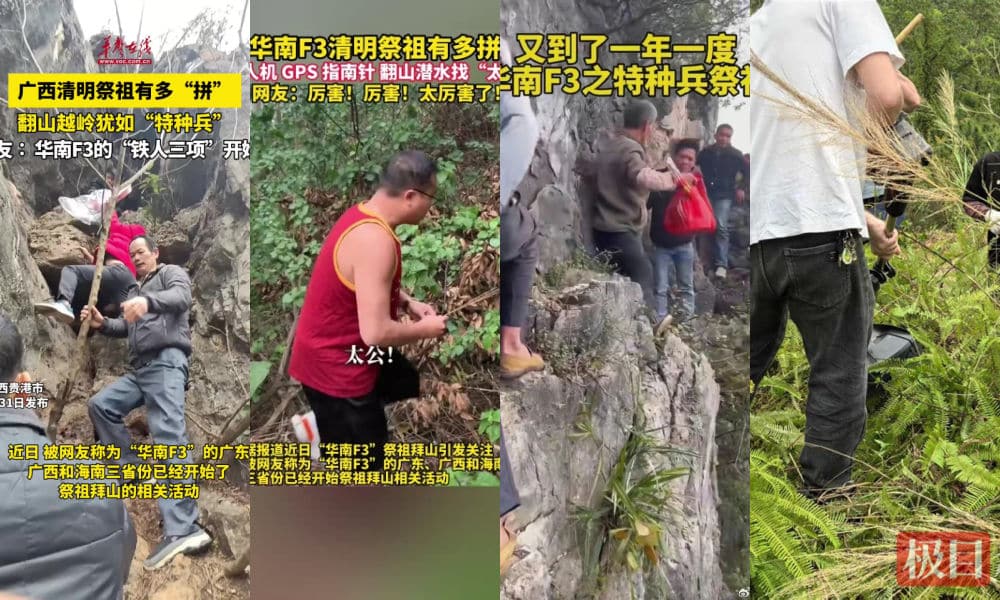
Tomb-sweeping days can feel more like a wilderness training for some in more remote and mountainous areas.
On Friday, Toutiao News reported that new technologies are now helping people pay respects when graves are located in remote, hard-to-access areas. Since 2021, one entrepreneur from Guangxi has been using drones to deliver offerings into the mountains. GPS apps help track routes to ancestral tombs, and robotic dogs are even being used to carry food and offerings up steep paths.
So while technology is making ancestral rites more efficient, it’s also adding new layers of intensity to rituals that perhaps were never meant to be fast-paced in the first place.
📱🐼 IShowSpeed and the Seven China Streams
Robots, drones, flying cars — they are not just becoming part of China’s old traditions, they’re also a major part of China’s new narratives, and this was particularly clear this week in the many hours of livestreaming by the famous American YouTuber IShowSpeed (Darren Jason Watkins Jr.).
After Shanghai, Beijing, and the Shaolin Temple in Henan, IShowSpeed continued to livestream from Chengdu, Chongqing, Hong Kong, and Shenzhen. His seven China streams together make up over 43 hours of footage, and I’ll admit that I’ve seen the great majority of it.
Last week, I already did a deep dive into the significance of IShowSpeed’s China tour, and how his streams have been used by Chinese official channels and state media as part of the strategy to tell China’s story well, and also to spread China’s message effectively — preferably through genuine and engaging stories. (In case you missed it, read the analysis here).
This week’s streams showed that both IShowSpeed’s team and the Chinese coordinators behind the scenes were even better prepared for the livestreamed visits and the enormous spectacle it brings to the places he goes. Some Chinese state media even started livestreaming his streams as well. In just ten days, Watkins has become a mega-celebrity in China, where he wasn’t that famous before — and he’s been trending on social media practically every day since March 24. Outside of China, his influence is also growing. During his Hong Kong stream, he reached a personal record of 38 million YouTube subscribers.
IShowSpeed is no longer just an American personality — he’s a marketing platform. Chinese authorities, state media, companies, brands, e-commerce channels, and influencers are all jumping in on the hype to benefit from his popularity.
From the top-down narrative perspective, his China tour has been a huge success. Kung fu performances, traditional opera, pandas, Chinese dance and music, local cuisine highlights, the Great Wall, traditional medicine and yin-yang, futuristic cities alongside ancient culture, high-speed rail, noodles, dancing aunties, and Shaolin monks — his streams became an ultimate representation of the Chinese cultural promotion playbook, and were reported on as such. China’s national broadcaster CCTV aired an entire 8-minute segment on his China tour, covering his adventures.
When Watkins’ livestreams started to include aerial drone footage with spectacular views — and especially when dancing with robots was added to the list of activities — I couldn’t help but see a resemblance between his 5+ hour stream and the famous Spring Festival Gala: a tightly programmed spectacle featuring Chinese opera, kung fu, and traditional cultural highlights mixed with cutting-edge technology.
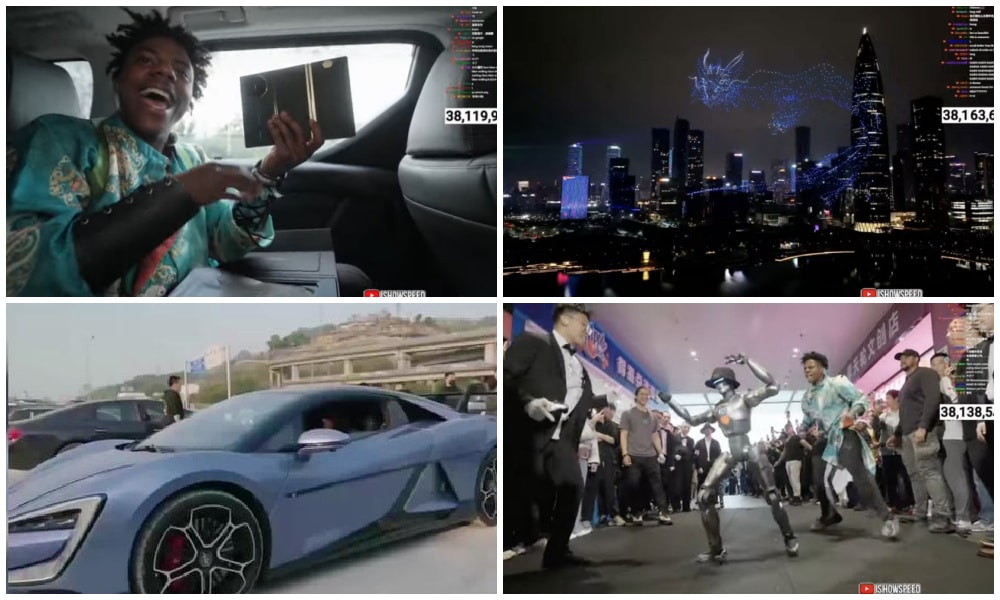
Watkins’ latest visit to Shenzhen especially became a celebration of Chinese tech. Not only did he do the robot dance and purchase three Huawei Mate X3 tri-fold phones (he also got futuristic BYD Yangwang U9 in Chongqing), the city had also organized a spectacular dragon drone show. Watkins also took a ride in a “flying car” — the EH216-S by tech company EHang (亿航). Just last week, EHang received official approval to operate the aircraft in China. While these flying vehicles will mainly be used for tourism and sightseeing at first, they’re expected to be part of low-altitude urban commuting in the future. Starting later this year, you’ll be able to try it out yourself in Hefei, where public tourism flights will begin.
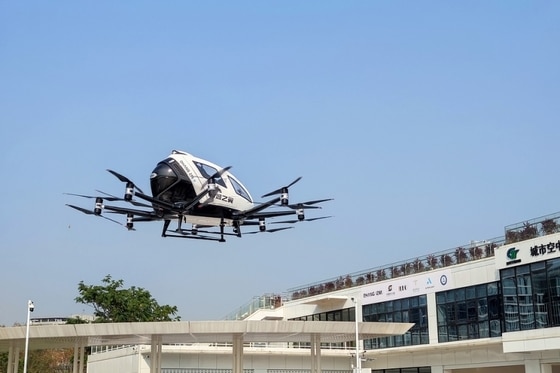
No wonder the EHang team was thrilled with the exposure. Besides a cultural ambassador to China, IShowSpeed’s been the best brand ambassador they could’ve hoped for.
At the same time, Watkins is anything but quiet, and his chaotic streams haven’t exactly brought moments of reflection during this year’s Qingming Festival. Today is a free day for him, offering some peace and quiet — for him, his team, and the entire circus surrounding the tour.
Wishing you a calm Sunday! Check out the rest of the newsletter here (link coming soon).
Special thanks to Miranda Barnes for contributing to this week’s issue. As always, thank you for your support — and don’t hesitate to reach out with any questions or suggestions.
Best,
Manya
(follow on X, LinkedIn, or Instagram)
Spotted a mistake or want to add something? Please let us know in comments below or email us. First-time commenters, please be patient – we will have to manually approve your comment before it appears.
©2025 Whatsonweibo. All rights reserved. Do not reproduce our content without permission – you can contact us at info@whatsonweibo.com.
Follow What’s on Weibo on

 China Insight11 months ago
China Insight11 months ago
 China Digital10 months ago
China Digital10 months ago
 China Arts & Entertainment11 months ago
China Arts & Entertainment11 months ago
 China Arts & Entertainment12 months ago
China Arts & Entertainment12 months ago







